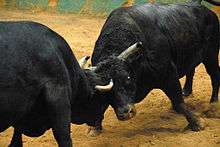Bull wrestling

Bull wrestling, cow fighting or bull fighting is a non-lethal bloodsport between bulls or cows found in some parts of the world.
Balkans
Korida, from corrida, or borbe bikova ("fights of bulls") is a traditional sport in former Yugoslavia. Grmeč, a mountain in the extreme west of Bosnia, is the best-known site of bullfights in the Balkans. They are called the Korida of Grmeč (Grmečka korida) and have been organised on every first Sunday in August for over 200 years, attracting thousands of visitors. These are fights between bulls themselves and there is no death of a bull. Fights happen in an empty field.[1]
The Corrida of Grmeč was depicted by the sculptor Slobodan Pejić. The sculpture of two bulls in a fight, made in bronze in 2004, has been compared to a confrontation of the oppressor and the oppressed or of the Bosnian people and the Austrian Emperor.[2]
Turkey
Bull wrestling in Turkey is known as boğa güreşi (literally "bull wrestling"). Each year in the third week of June, the Kafkasör (Caucasus) festival takes place in the city of Artvin. At the beginning of the festival, certain rules are applied in order to save the bulls from injury. For example, if a bull retreats from the fight, it means defeat, etc.[3]
East and Southeast Asia
- Tōgyū, or "Okinawan bullfighting", is the traditional sport of the Ryukyu Islands, in which two bulls attempt, as in sumo wrestling, to push one another out of a ring.[4]
- Sossaum (Korean: 소싸움) is a traditional sport of Korea, in which two oxen are pitted against each other.[5]
- Bullfighting is also observed by the ethnic Hmong/Miao minority in China, Vietnam and Laos. Bulls are selected by age, horn length and size. They are enticed to fight usually after new year's or summer events. They are usually non-lethal events and bulls that carry the opposing bulls will get the most points if it is a draw. The loser is usually the bull that flees first even if winning.
Western Asia
.jpg)
In Oman and the United Arab Emirates two Brahman bulls are presented to each other and allowed to lock horns and fight, while their handlers hold ropes to separate them if necessary.[6] The origins of bullfighting in Oman are unknown, though locals believe it was brought here by the Moors who had conquered Spain. Its existence in Oman and the UAE is also attributed to Portugal, which colonized the Omani coastline for nearly two centuries,[7][8] and also introduced bullfighting to Omani Zanzibar.[9]
South Asia
Dhiri or Dhirio (Konkani: धिरी,धिरयो) is a popular form of traditional bull wrestling in the state of Goa, Coastal South West India. It was the weekend entertainment staple for most villages. Many families lived off the earnings made on appearance money and bets alone.[10] The Panaji Bench of the high Court vide order dated 20.12.96 directed the State Government to take immediate steps to ban all types of animal fights including Dhiri organised in the State of Goa, which was finally banned in 1997.[11] Dhiri bullfights are still very popular in Goa despite the ban. There have been demands for legalizing Dhiri.[12]
Criticism
On 17 October 1987, during its 10th session, the Islamic Council discussed the practices of bullfighting and animal pits (where two or more animals are agitated and forced to fight each other for the sole purpose of entertainment), and issued a fatwa that both are considered haraam (forbidden by Allah) due to their cruel nature.[13]
See also
- Bull-baiting
- Bullfighting
- Camel wrestling
- Alligator wrestling
- Cockfight
- Combat de Reines, cow wrestling in Switzerland
- Dog fighting
- Horn fighting, the way horned ungulates fight
References
- ↑ "Bullfights of Grmec". Atlas Obscura. Retrieved 16 February 2012.
- ↑ (in Slovene) Vanda Mušič (ed). Bassin, Aleksander. Kokot, Staša. Slobodan Pejić. Self-published by Vanda Mušič Chapman. 2007. ISBN 978-961-245-325-1.
- ↑ Diana Darke (2011). Eastern Turkey. Bradt Travel Guides. pp. 334–. ISBN 978-1-84162-339-9. Retrieved 15 September 2013.
- ↑ Susan Sered Associate Professor in the Department of Sociology and Anthropology Bar-Ilan University (12 February 1999). Women of the Sacred Groves : Divine Priestesses of Okinawa: Divine Priestesses of Okinawa. Oxford University Press, USA. pp. 119–. ISBN 978-0-19-535233-7. Retrieved 15 September 2013.
- ↑ The National Folk Museum of Korea (South Korea) (30 October 2014). Encyclopedia of Korean Seasonal Customs: Encyclopedia of Korean Folklore and Traditional Culture Vol. 1. 길잡이미디어. pp. 225–. ISBN 978-89-92128-92-6.
- ↑ Diana Darke (2010). Oman: The Bradt Travel Guide. Bradt Travel Guides. pp. 29–. ISBN 978-1-84162-332-0. Retrieved 15 September 2013.
- ↑ Mangalorean.Com- Serving Mangaloreans Around The World!
- ↑ Ibrahim Abed; Peter Hellyer (2001). United Arab Emirates: A New Perspective. Trident Press Ltd. pp. 72–. ISBN 978-1-900724-47-0. Retrieved 15 September 2013.
- ↑ Africa Analysis: The Fortnightly Bulletin on Financial and Political Trends. Africa Analysis. 2004. p. cxxxi. Retrieved 15 September 2013.
- ↑ Kamat Maad, Govind (Oct 22, 2008). "Dhirio: Bullish about a banned fight". The times of India. TNN. Retrieved 26 April 2015.
- ↑ India. Parliament. House of the People (1998). Lok Sabha Debates. Lok Sabha Secretariat. p. 152.
- ↑ "UGDP claims credit for legalising dhirios". O Heraldo. 26 Mar 2009. Retrieved 26 April 2015.
- ↑ حكم الملاكمة ومصارعة الثيران والمصارعة الحرة |
External links
| Wikimedia Commons has media related to Bull wrestling. |
- "Borbe bikova". VICE Srbija.